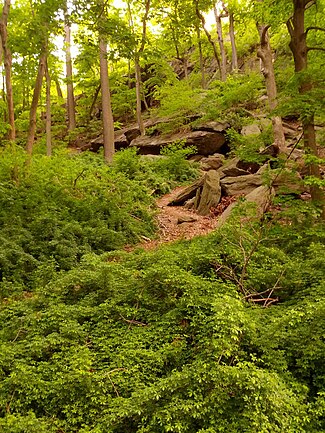Inwood Hill Park
| Inwood Hill Park | |
|---|---|

Native American caves
|
|
| Type | Urban park |
| Location | Inwood, Manhattan, New York City |
| Area | 196.4 acres (79.5 ha) |
| Created | 1926 |
| Operated by | New York City Department of Parks and Recreation |
Coordinates: 40°52′21″N 73°55′33″W / 40.872458°N 73.925886°W
Inwood Hill Park is a city-owned and maintained public park in the Inwood neighborhood of Manhattan, New York City, operated by the New York City Department of Parks and Recreation. Situated on a high schist ridge that rises 200 feet above the Hudson River from Dyckman Street to the northern tip of the island, Inwood Hill Park's densely folded, glacially scoured topography contains the largest remaining forest land on Manhattan Island. Unlike other Manhattan parks, Inwood Hill Park is largely natural, being non-landscaped. As the current name suggests, large areas of the park are hills, mostly wooded.
Inwood Hill Park has a human history that goes back to the Pre-Columbian era. Through the 17th century, Native Americans known as the Lenape inhabited the area. There is evidence of a main encampment along the eastern edge of the park. The Lenape relied on both the Hudson and Harlem Rivers as sources for food. Artifacts and the remains of old campfires were found in Inwood's rock shelters, suggesting their use for shelter and temporary living quarters. Legend has it that under a tulip tree in the park Peter Minuit, Director General of New Netherland, 'purchased' Manhattan from the a band of Native Americans in 1626 for the Dutch West India Company; the purchase price being a shipment of goods worth 60 guilders. The tree, the largest tulip on the island, survived for centuries until it was felled by a storm in 1933. Until the 1950s the base of the tree under which this transaction allegedly took place was still to be seen, surrounded by a large iron fence, but as it rotted it was finally removed and a boulder (Shorakkopoch Rock) and plaque replaced it.
...
Wikipedia
